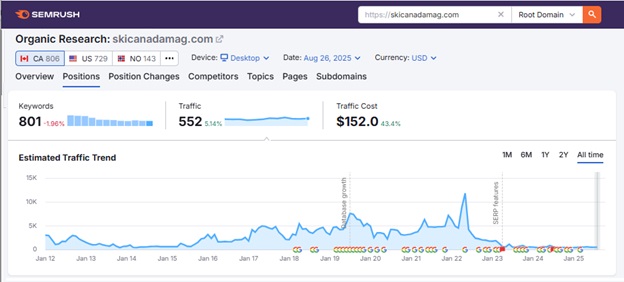September 7, 2025 | Robert Campbell
11 min read
This year, 2025 has seen the largest shift away from Google’s search engines since the company first launched its service, two-and-a-half decades ago. Why? What is causing this unprecedented disruption of their market dominance? AI-powered search assistants like ChatGPT, Perplexity, and Google’s own Search Generative Experience have turned the usual exercise upside down by doing all the work for the user. The new players are winning the public’s respect by rapidly answering questions, listing solutions, and even making brand recommendations. It’s an incredible evolution and it’s causing a huge disruption because of how rapidly it’s changing publishing and the digital marketing landscape.
Organic Search Traffic Has Plummeted
While creative people are posting their AI experiments on their social channels, seemingly amazed (and feeling a little threatened) with the possibilities unlocked by their new tools, business owners are left scouring their Google Analytics reports for any trace of their missing traffic. Commercial websites, online blogs and magazines that once entertained thousands of visitors now receive only a few dozen daily visits, and these are mostly brand searches. Many marketing and sales models are broken.
Below is SEMrush’s traffic chart for BlogTO.com, a news & lifestyle magazine for Toronto, Canada. The website enjoyed over five million visits a month in 2020, but now receives only a tenth of that total.
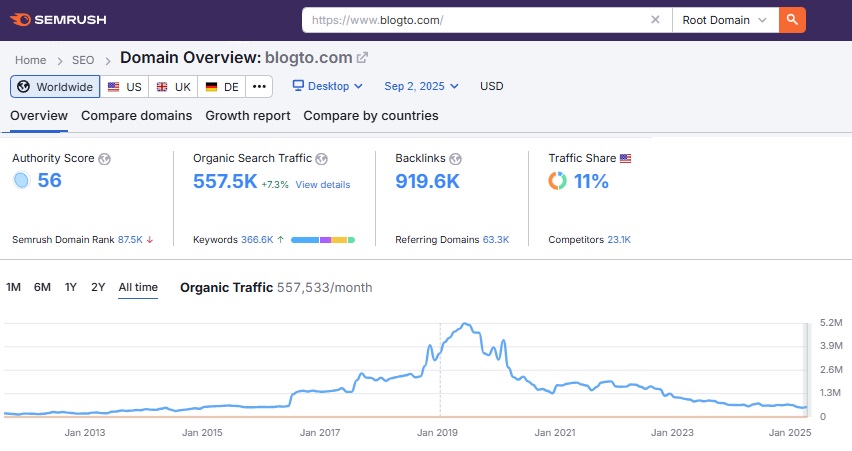
SEMrush shows BlogTO’s all time history, and a dramatic leveling. The Toronto news & lifestyle blog went from the height of their importance during Covid back to the traffic totals they had ten years ago.
AI overviews have caused this sharp decline in organic search traffic, and the success of this new and mostly free service is leaving advertisers to reconsider their content marketing strategies. Shallow, sponsored content is truly useless today, and most blogs and magazines which accepted ‘guest posts’ that were highly derivative will find, in their Google Search Console, that content is now labeled, crawled but not indexed which is Google’s way of saying it’s not good enough to display as solutions to user queries.
Below is the same SEMrush report for Ski Canada Magazine which shows a similar decline. The website entertained over four thousand visits a month in 2020, but the same portal only received 552 visits in August 2025. Their only pages worth reading, in Google’s estimation, is their reporting on Quebec ski hills where the author snapped his own pictures and wrote expert reviews.
At this point, I estimate about sixty percent of all searches yield no visits, as AI-generated answers satisfy users directly on the search results page. Additionally, Google’s AI Overviews push the top-ranked results down the page, as much as two full-screen-scrolls on a desktop, and three screen-scrolls on a mobile device, significantly lowering click-through rates, even for the top-ranked organic results.
Informational content providers and publishers of guide-books and how-to tutorials are the hardest hit. AI Overviews provide crystal clear in-depth answers within search results thus eliminating any need to click through to the actual resources. This shift is particularly damaging for content marketers who have built information-funnels to create awareness. So what’s the remedy?

In Clint Eastwood’s 1992 film Unforgiven, W.W. Beauchamp accompanies English Bob to Big Whiskey to write a first-person account of him avenging a woman and bringing evil doers to justice.
Primary Source Reporting is Time Consuming, and Expensive, but Necessary for SEO Success.
As the Search Experience Officer at KPDI, I’m uniquely positioned to test my own theories and to make content which pleases human readers and AI cache bots and thus becomes popular search results. Watching our competitor’s response to AI dominating search has been informative because there is no textbook for our industry. In SEO, we all learn by doing, testing and trying new things. KPDI’s marketing teams have fostered new tactics and I’m shaping my own best practices with regards to publishing important content. I’m leveraging experts.
Best Practices for Publishing AI SEO-Friendly Content
When creating content for answer engines, as AI generative search is now being called, the old rules still apply. At KPDI, we preach and practice flawless on-page SEO; we’re big on reshaping the target page’s Meta Title and H1 header to set an achievable focus, and then we use the sub headers, image ALT text and body copy to expound the concept’s many facets, creating ‘search diamonds’ with shiny faces to be promoted in social media. All freshly repaired pages will then receive beneficial incoming links from other pages (internal links), as well as links from 3rd party articles and blogs in a content marketing funnel. That’s good digital marketing and it succeeds brilliantly when it builds a highly usable destination. But all of this is yesterday’s SEO best practice.
To stand out in AI-driven search results today, our published content needs to be wholly original and answer real questions, and not just repeat popular keywords. It should anticipate follow-up questions, and be written in a natural, conversational tone, and our pages must offer something truly useful. To do all this, I like to profile an expert with a unique perspective, relating his or her quotes, capturing original images, and transcribing other proprietary data.
Primary journalism, being the source, succeeds in AI SEO because the scraping & sifting programs hunt for rare information above all things. Readers can assume everything printed in their local library is already online and within AI purview, and so we must ask, how can we gather new fresh material which is interesting to humans and for which we will be the primary source for AI mash-ups? The answer is easy to write but hard to do; you have to physically travel to the site and take original photos and find experts and insiders willing to give quotes and share rare information.
Above all, be honest: AI programs scraping and processing algorithms prioritize trustworthy, well-established news sources which have built strong reputations for accuracy and depth. Trusted sources are cited more frequently by AI Overviews in Google Search, giving them greater visibility. Search any current news event and you’ll see how major organs-of-the-press like the BBC, New York Times, and CNN dominate the listed sources in AI-generated search results, highlighting the importance of brand and also their consistent quality as defined by traffic and engagement.
What is the Difference Between SEO and AEO?
SEO (Search Engine Optimization) focuses on improving a website’s visibility and ranking on traditional search engine results pages (SERPs) by optimizing content and technical aspects, while AEO (Answer Engine Optimization) targets the way content is displayed in featured snippets, answer boxes, and through voice search, by providing direct, concise answers to user queries to increase visibility in zero-click search results. In essence, SEO gets your content found, and AEO gets your content answered directly on the spot, often used in conjunction to provide a comprehensive strategy.
What is the Difference Between AEO and AI SEO?
AEO (Answer Engine Optimization) optimizes content to be directly featured in AI-generated answers, while AI SEO is a broader term encompassing the use of AI to improve traditional SEO tactics, such as using AI for keyword research and content creation to rank higher in search engine results pages (SERPs). In essence, SEO traditionally focuses on ranking web pages, whereas AEO focuses on being the source for direct, conversational answers, with AI SEO being a methodology that supports both.

W.W. Beauchamp’s previous work, The Duke of Death, a printed book, epitomizes secondary media, which in this case is mostly hearsay and untrue (despite containing English Bob’s own testimony, which is a lie.)
AI SEO Compels Content Creators to Become Primary Sources
When I think of real journalism, my mind conjures memories of W.W. Beauchamp in Clint Eastwood’s 1992 film, Unforgiven. Played by Saul Rubinek, the journalist is the biographer of the outlaw gunman English Bob, accompanying him to Big Whiskey to write about his adventures. This is newspapering, and shoe leather journalism in the most extreme circumstances; Beauchamp is like a modern war correspondent, but one without any protective gear or support. He’s a truth-seeker willing to risk his own life to relate the exact details of a true story.
What is Shoe Leather Journalism?
Basic, old-fashioned news gathering is called shoe-leather journalism or shoe-leather reporting. It’s journalism which involves walking from place to place, observing things first hand and speaking to people, rather than sitting indoors at a desk.

After William Munny massacres Little Bill and his men, W.W. Beauchamp asks whom he shot first, and the order in which he killed his opponents, seeking to preserve the true details, and to make an accurate record of the event.
We should all strive to become primary sources, instead of cutting & pasting easy research into useless ‘listicals’, as so many marketing companies are still doing today, we should put on our Press hats and use our cameras and other devices to become first-person reporting agents. Take this a step farther and you’ll realize that instead of publishing new material every week, it’s better to improve older entries. Start with those already cited in answer engines for any reason. Fix up what you have, and then hunt for whales. Going forward, spend three times longer than usual writing new pieces and do first-person reporting as much as possible with every new entry. Build-up your reputation in particular niche, as you broadcast your search-concepts’ shiniest faces in your social media channels.
The Independent, Authentic Review Blogger is Relevant Again
Big World, Small Girl is a lifestyle and travel blog based in Austin, Texas, with a strong focus on the craft beer scene and local foods. The blog’s creator shares personal experiences and recommends local breweries, food establishments, travel destinations, and events, often highlighting outdoor activities and unique culinary experiences. I’m showing you Caitlin because what she’s doing is working.
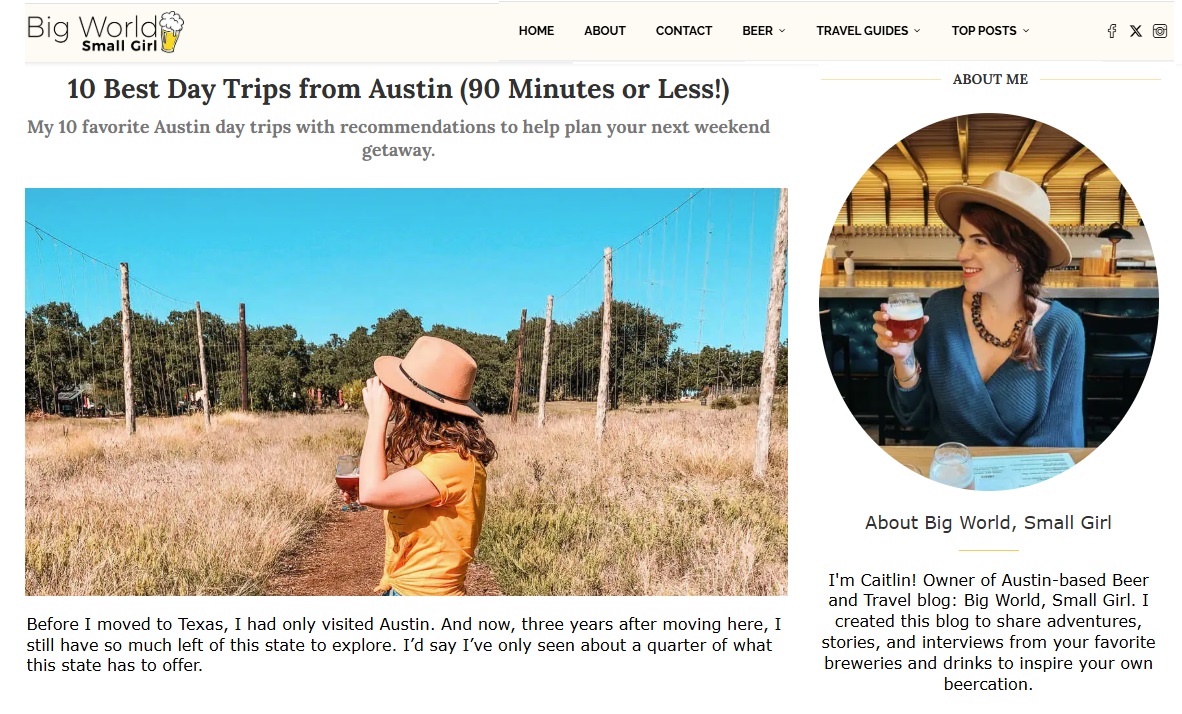
Caitlin is authentic and writes in the first person about her real life travels and beer tastings. Her easily-measured SEO success is not surprising; but you might raise an eyebrow when I tell you her traffic increase is because the AI search bots love her stuff. SEMrush shows a steady rise in traffic because her content is regularly featured in answer engines. Her work is cited when AI answers repackage her tips and advice relating to the travel destinations she reviewed. She has made herself the most relevant subject matter expert.
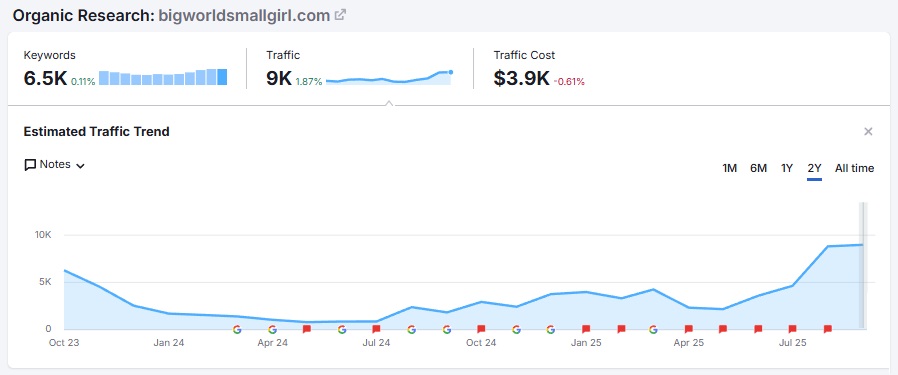
Her content is laid out perfectly with h3 sub headers sharing the unique features and giving each of her blog entries depth and nuance. Below is one section of an article entitled Top Ten Small Towns to Visit One Hour Drive from Austin, Texas, which is pretty specific and is a well focused h1 header. The h2 headers are the town names, and h3 headers exhibit the features of the town.
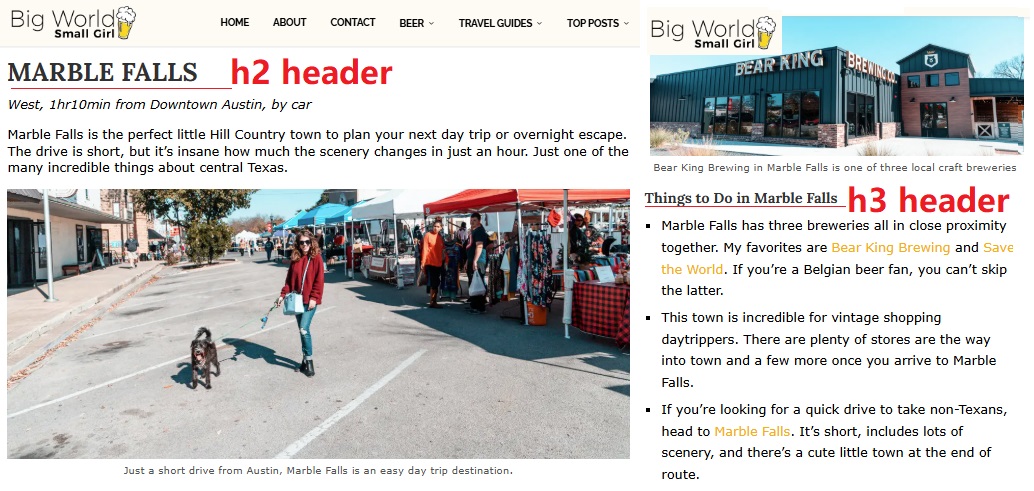 Caitlin’s blog checks a lot of boxes; she’s a good photographer and an attractive photo subject, and she’s a good author who writes in first person past tense, and a dog owner who likes drinking beer.
Caitlin’s blog checks a lot of boxes; she’s a good photographer and an attractive photo subject, and she’s a good author who writes in first person past tense, and a dog owner who likes drinking beer.
Making Primary Media as SEO for Regarding Luxury Magazine
An interesting case study in its own right, we recently signed-on to help the editor and owner of Regarding Luxury magazine reformulate his approach to sponsored advertising in the age of generative search. His traffic was dipping too and he came seeking solutions, not theories. We told him it wouldn’t be a quick fix because there’s no easy remedy – older articles can be improved of course, but real improvement often requires ‘boots on the ground’, real photos, quotes and rare information that is best collected in person, offline.

To put my money where my mouth is, I’ve gone and done the job myself, writing comprehensive accounts and experiential pieces about being Inside the 2025 AFA Canada Fashion Expo, and more recently, How to Invest in Art with Marshall Gummer really puts into practice what we’ve discussed. Good header hierarchy reinforces strong keyword-search concepts preserved in expert quotes, rare information, and original photos all have proper reinforcing ALT text. These are little giftboxes of expert content wrapped and laid out like presents for answer engines to find, test and display as part of their mash-ups. We want to get in the mix and win the visits with our pictures, quotes and unique perspectives. Stay tuned for this case study and an honest analysis of the results.
Are you seeking an SEO solution to turn around your own sagging traffic situation? Let’s have a look.
